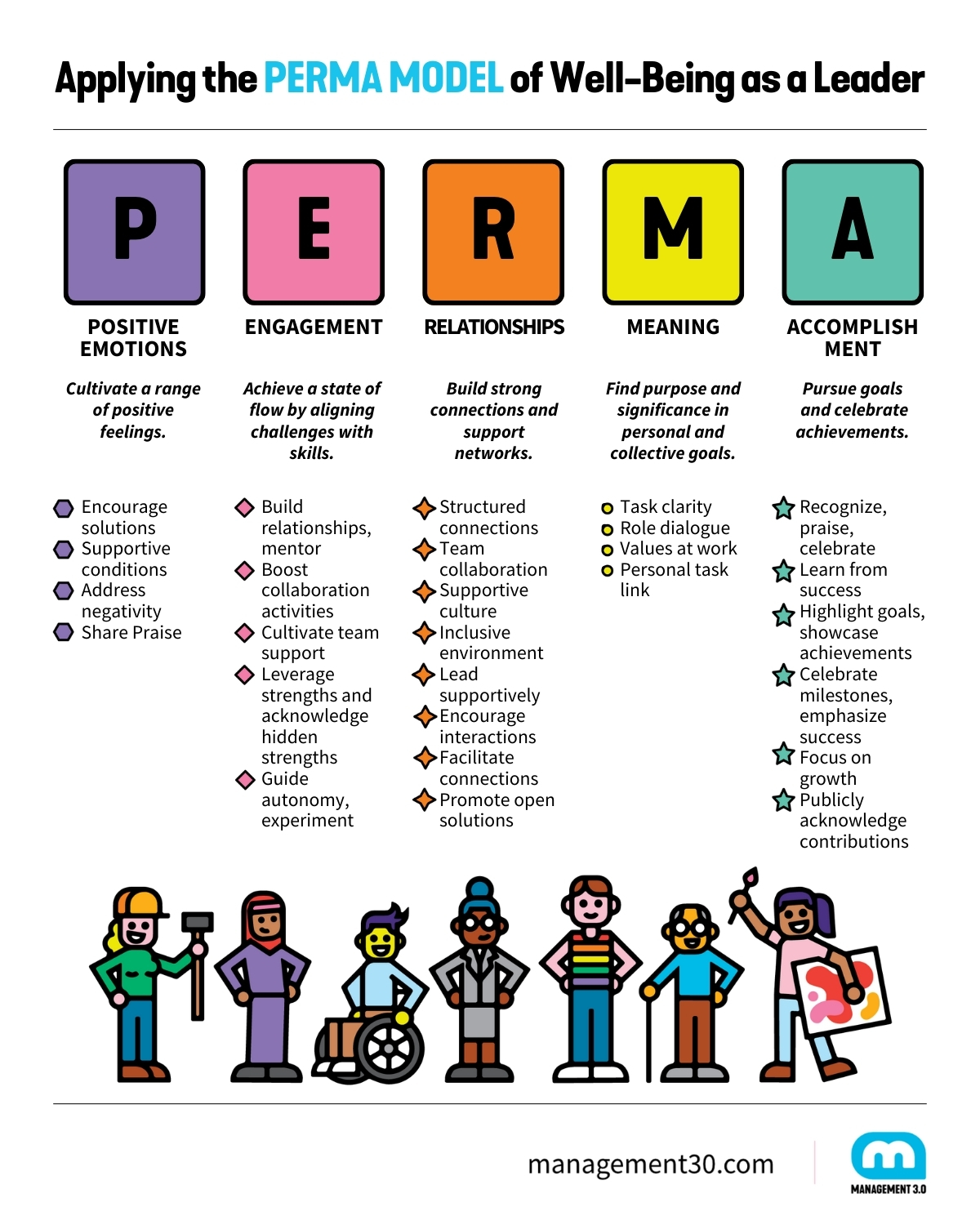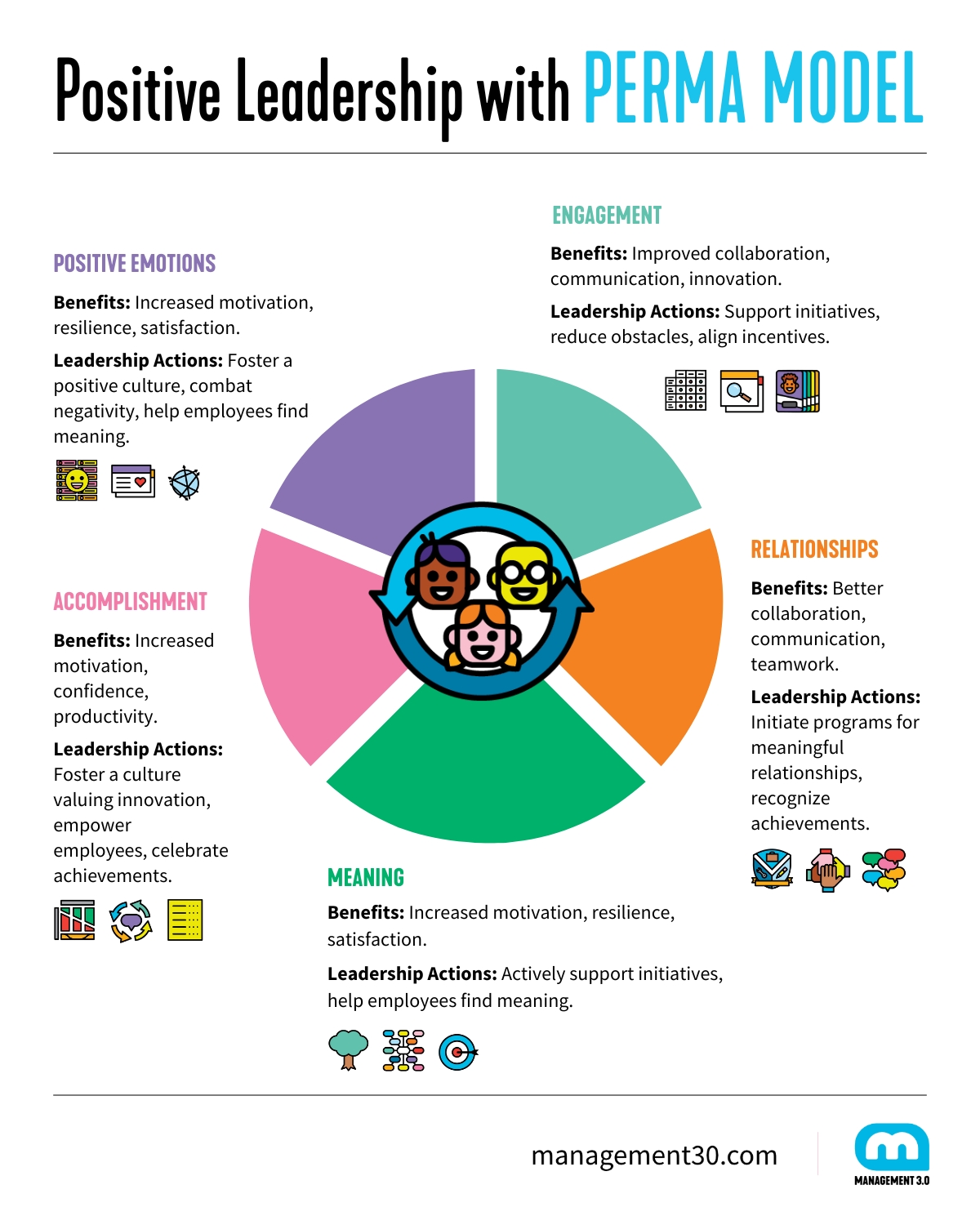Positive psychology offers leaders powerful tools to create thriving workplaces. This is particularly vital for Antony Nizamoglou, an expert in Management 3.0 and Enterprise Agility Coaching, who witnesses the joy organizations experience when embracing a positive culture. In this article, we explore positive psychology and how the PERMA model can contribute to a happy and fulfilling work life.
As a leader and an individual, you have an impact on your immediate environment from a personal perspective. Your influence extends to the surrounding workplace environment. Aim to be self-aware with a positive and mindful stance. Apply positive psychology to human challenges in the workplace.
By emphasizing strengths, fostering resilience, promoting well-being, and enhancing relationships, leaders can inspire and set the context for their teams to reach their full potential. This enables them to perform at their best and flourish, driving organizational growth.
What is Positive Psychology?
Positive psychology, emerging in the late 20th century, focuses on well-being, happiness, and the positive aspects of life. It shifts away from traditional psychology’s emphasis on mental illnesses, zeroing in on strengths, positive emotions, resilience, optimism, and flow. This shift is crucial for individuals aiming to lead more meaningful and fulfilling lives.
Why is Positive Psychology Important?
By directing attention towards strengths, positive emotions, engagement, meaningful relationships, and accomplishments, positive psychology fosters a positive work environment. Leaders can leverage these principles to inspire and motivate teams, cultivating a culture of collaboration, resilience, and job satisfaction. This approach not only enhances individual work experiences but also contributes to the overall success and productivity of organizations.
The PERMA Model and Leadership
Martin Seligman’s PERMA model, introduced in 2011, outlines five essential elements for well-being: Positive Emotion, Engagement, Relationships, Meaning, and Accomplishment.

Positive Emotion (P)
Leaders should embrace positive emotions like hope, joy, and gratitude to create a vibrant work environment. Encouraging self-reflection and building a sense of belonging transforms mindsets, fostering trust and collaboration. Leaders play a key role in influencing a positive atmosphere, addressing negativity, and reducing stressors.
Management 3.0 Practices
- Share gratitude and appreciation with Kudo Cards.
- Understand and visualize relationships within your organizational systems to further understand the causes and effects of Connection Circles.
- Create conditions for a happy, thriving organizational environment with the 12 Steps to Happiness.
Shawn Achor, a leading positive psychology researcher, gained widespread recognition for his TED Talk, “The Happy Secret to Better Work.” In the talk, Achor challenges the notion that success precedes happiness, advocating for the reverse. He introduces the “happiness advantage,” asserting that a positive mindset leads to increased success. Achor blends humor with scientific insights, offering practical strategies to cultivate happiness, such as gratitude practices and acts of kindness. His engaging presentation has resonated globally, contributing to the popularization of positive psychology concepts and highlighting the transformative power of happiness on personal and professional achievement.
Engagement (E)
Enhancing engagement involves aligning individual strengths with organizational needs, unlocking improved performance and positive behaviors. Leaders can promote autonomy, encourage flow experiences, and establish programs for meaningful relationships and mentorship.
The good life consists in deriving happiness by using your signature strengths every day in the main realms of living. The meaningful life adds one more component: using these same strengths to forward knowledge, power or goodness.
Martin Seligman
The concept of flow experience, introduced by psychologist Mihaly Csikszentmihalyi, refers to a state of optimal engagement and focus in which individuals become fully immersed in a challenging task. This immersive state occurs when the level of skill matches the level of challenge, resulting in a harmonious and highly satisfying experience. Achieving a flow state often leads to increased creativity, heightened productivity, and a deep sense of fulfillment. Employees who regularly experience flow are more likely to find joy and meaning in their work, contributing to a positive and thriving workplace culture. Cultivating environments that encourage such optimal experiences can enhance job satisfaction and overall well-being among employees.
Management 3.0 Practices
- Identify strengths and opportunities for growth with a Team Competency Matrix.
- Find out the key motivators for each team member and what is essential for them with Moving Motivators.
- See what responsibilities your team is ready to take on and what are areas they might feel they still need your support to make decisions with Delegation Poker.
At Management 3.0 we have modules on Worker Happiness and Emotional Intelligence. Dive deeper into these topics in one of our workshops.
Relationships (R)
Building positive relationships is vital for team success. Leaders should support programs that cultivate meaningful connections, mentorship, and learning communities, promoting collaboration and mutual support.
Management 3.0 Practices
- Build communities that share challenges and experiences with Business Guilds.
- Huddle up and make decisions with Corporate Huddles.
- Focus on peer growth with Improvement Dialogues.
Meaning (M)
Meaning is illuminated when individuals align personal purpose with organizational objectives. Leaders can communicate task significance clearly, engage in dialogues to understand employee roles, and encourage the infusion of personal values into work.
See the Management 3.0 Meaning and Purpose module, part of our Agile People Leadership Workshop.
Management 3.0 Practices
- What does your team consider valuable, and how does this fit into what your organization considers valuable? Value Stories can help.
- Learn more about your people and find what makes them tick with Personal Maps.
- Start building a value-oriented culture, communicating the organizational goals, and negotiating how to make it happen by aligning and connecting with your team’s contributions through OKRs.
Accomplishments (A)
Leaders should cultivate a culture of innovation, autonomy, and aligned incentives, openly recognizing achievements and celebrating milestones. This approach fosters a positive, supportive environment.
When we take time to notice the things that go right – it means we’re getting a lot of little rewards throughout the day.
Martin Seligman
Management 3.0 Practices
- Map the learnings from successes and failures with Celebration Grids.
- Share feedback with Feedback Wraps, Feedback Lottery, and 360-Degree Dinner according to the context.
- Form your next experiment with the Experiment Hypothesis.

Applying the PERMA-Model as a Leader
Kumiko Sugiyama, Management 3.0 Facilitator, Positive Psychology Practitioner and participant of the Well-Being Week 2024 in Japan, shares
In my daily use of positive psychology, I employ a simple tool called the “Where are you now?” ladder. This concept was introduced by Hadley Cantril, a pioneer in social research, in his 1965 book “The Pattern of Human Concerns.” Another measure of fulfillment, introduced in the book “Wellbeing at Work” by Jim Clifton and Jim Harter, is “GNT (Gallup Net Thriving).” I discovered GNT in a positive psychology coaching course, and it had such a significant impact that I implemented it immediately.
I also work as a Japanese language trainer, using this tool to help individuals visualize their proximity to their goals, even if they struggle to articulate them verbally. It’s effective for both adults and children, fostering introspection:
The Ladder of Life
The top of the ladder represents your most ideal life, while the bottom signifies your worst life.
- On which rung of the ladder do you think you are currently standing? (0-10)
- In your imagination, about 5 years from now, on which rung of the ladder do you think you will be standing? (0-10)
By gently guiding individuals through this exercise, I gain insights into their personality and learning style, akin to a self-assessment. Observing their behavior and psychology, I adapt my communication and actions accordingly. Whether they respond better to subtle encouragement or more direct guidance, I adjust my approach based on their unique personality. This process involves active listening, careful observation, and thoughtful consideration of the most effective ways to empower and engage with each individual.
It also helps to understand the current state of affairs and encourages further challenges. I think the term “challenge” is relevant to any aspect of the PERMA model; a new challenge may arise through reflection on actions to elevate oneself on the ladder (to improve the score). If your work involves children, you can offer support while listening; with adults, you can provide guidance. This approach can also be motivational in both professional and personal life, and the outcomes can be visualized using Celebration Grids.
In conclusion, positive psychology, applied through the PERMA model and Management 3.0 practices, can create healthier, thriving organizations. By emphasizing positive emotions, engagement, relationships, meaning, and accomplishments, leaders can develop programs that support well-being, resilience, and engagement, ultimately contributing to a positive and productive workplace.
What you need to know about Positive Psychology
- Positive psychology is a branch of psychology that focuses on the positive aspects of human experience, well-being, and personal strengths.
- It emerged as a response to traditional psychology’s predominant focus on mental illnesses and dysfunction.
- Martin Seligman, often considered the founder of positive psychology, introduced the PERMA model, highlighting five essential elements for well-being: Positive Emotion, Engagement, Relationships, Meaning, and Accomplishment.
- Positive psychology aims to enhance individuals’ overall life satisfaction, happiness, and fulfillment.
- It emphasizes the cultivation of positive emotions, strengths, resilience, optimism, and a sense of meaning in life.
- Applications of positive psychology extend to various domains, including education, workplace settings, mental health, and personal development.
- Positive psychology interventions include exercises and practices designed to improve well-being, such as gratitude journals, mindfulness, and character strengths assessments.
- The field recognizes the importance of fostering positive relationships, social connections, and a sense of community for overall happiness.
- Well-being is viewed as a multifaceted concept, encompassing emotional, social, and psychological dimensions.
- Positive psychology complements traditional psychology by providing a more comprehensive understanding of human flourishing and optimal functioning.

